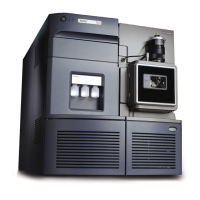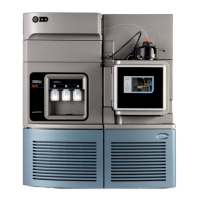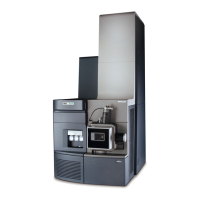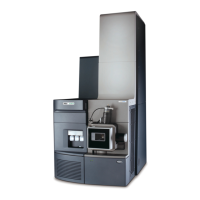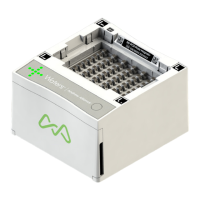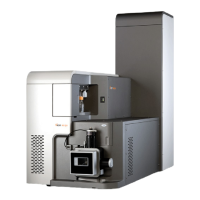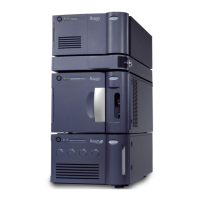Do you have a question about the Waters Xevo TQD and is the answer not in the manual?
Provides details on how to contact Waters via Internet, telephone, and conventional mail.
General safety advice for handling reagents and samples, and following good laboratory practice.
Details specific hazards like solvent leakage and flammable solvents, with warnings and precautions.
Covers the risks of overloading the instrument and hazards associated with broken glass or falling objects.
Warns about hot components, specifically the source ion block, and precautions during maintenance.
Details personal contamination risks from hazardous materials during decontamination.
Refers to Appendix A for a comprehensive list of warning and caution advisories.
Explains symbols used in the manual and on the instrument, along with their definitions.
Defines the target audience and the guide's purpose in overviewing the instrument.
Specifies the instrument's design for research use and its limitations regarding diagnostic procedures.
Provides guidance on calibrating LC systems and performing quality control sample analysis.
Describes the Xevo TQD's capabilities and compatibility with various Waters and third-party sources.
Explains ionization methods like ESI, ESCi, APCI, and APPI/APCI sources.
Details the functionality and system operation of the IntelliStart Fluidics system.
Explains the principles of the mass spectrometer's ion optics and provides an overview diagram.
Describes MS and MS/MS operating modes like SIR, MRM, PICS, RADAR, and Constant Neutral Loss.
Covers how samples are delivered to the probe and the function of leak sensors.
Explains the vacuum system and details the instrument's rear panel connectors.
Step-by-step guide for powering on and starting the mass spectrometer.
Instructions for installing reservoir bottles and related materials.
Procedures for rebooting the instrument and leaving it ready for operation or in standby mode.
Procedure for shutting down the instrument in an emergency situation.
Details on installing, removing, and using the ESI probe.
Information on ESCi applications and optimizing the ESI probe for ESCi, plus APCI mode.
Step-by-step instructions for installing and removing the IonSABRE II probe for APCI mode.
Explains APPI, APCI, and dual-mode operation for the combined source.
Covers the NanoFlow source assembly, installation, and capillary fitting procedures.
Lists periodic maintenance schedules and information on ordering spare parts.
Guidance on troubleshooting with Connections INSIGHT and general safety and handling procedures.
Steps for removing/refitting the source enclosure and installing/removing the corona pin.
Instructions for operating the source isolation valve and removing/replacing O-rings and seals.
Procedures for cleaning the instrument case and emptying the exhaust trap bottle.
Covers gas ballasting, checking/adding oil, and replacing oil demister elements for the roughing pump.
Details on cleaning sampling cone, extraction cone, and ion block assemblies.
Procedures for cleaning the ion guide assembly and its components like the differential aperture.
Guides for replacing ESI probe tips, gaskets, and capillaries, and IonSABRE II probe capillaries.
Procedures for cleaning/replacing corona pins, IonSABRE II probe heaters, and ion block source heaters.
Covers replacing source assembly seals and the instrument's air filter.
Instructions for changing roughing pump oil and replacing its oil demister element.
Procedures for changing UV lamp bulb, cleaning lamp window, and replacing APPI lamp drive seals.
Guidance on how to replace the instrument's fuses, including safety warnings.
Explains various warning symbols and their specific meanings related to instrument use and hazards.
Covers specific warnings like tubing burst, flammable solvents, electric shock, and biohazards.
Details chemical hazard warnings and the meaning of the caution symbol.
Lists warnings applicable to all Waters instruments and defines electrical and handling symbols.
Details the rear panel connections for external wiring and vacuum systems.
Provides instructions for connecting both oil-filled and oil-free roughing pumps.
Covers connecting the nitrogen gas supply and exhaust lines.
Instructions for connecting collision cell gas supply and the nitrogen exhaust line.
Details on connecting the liquid waste line and the workstation, including Ethernet cables.
Explains I/O signal connectors, including pinouts and signal connection procedures.
Guidance on connecting the instrument and roughing pump to the power source.
References external documentation for preventing contamination in LC/MS systems.
Lists instrument components exposed to solvents and their materials of construction.
Lists common solvents used for mobile phases in reverse-phase LC/MS.
References contamination prevention and describes the selector valve's ports and connections.
Provides a plumbing schematic and details tubing and connector specifications.
Provides details on how to contact Waters via Internet, telephone, and conventional mail.
General safety advice for handling reagents and samples, and following good laboratory practice.
Details specific hazards like solvent leakage and flammable solvents, with warnings and precautions.
Covers the risks of overloading the instrument and hazards associated with broken glass or falling objects.
Warns about hot components, specifically the source ion block, and precautions during maintenance.
Details personal contamination risks from hazardous materials during decontamination.
Refers to Appendix A for a comprehensive list of warning and caution advisories.
Explains symbols used in the manual and on the instrument, along with their definitions.
Defines the target audience and the guide's purpose in overviewing the instrument.
Specifies the instrument's design for research use and its limitations regarding diagnostic procedures.
Provides guidance on calibrating LC systems and performing quality control sample analysis.
Describes the Xevo TQD's capabilities and compatibility with various Waters and third-party sources.
Explains ionization methods like ESI, ESCi, APCI, and APPI/APCI sources.
Details the functionality and system operation of the IntelliStart Fluidics system.
Explains the principles of the mass spectrometer's ion optics and provides an overview diagram.
Describes MS and MS/MS operating modes like SIR, MRM, PICS, RADAR, and Constant Neutral Loss.
Covers how samples are delivered to the probe and the function of leak sensors.
Explains the vacuum system and details the instrument's rear panel connectors.
Step-by-step guide for powering on and starting the mass spectrometer.
Instructions for installing reservoir bottles and related materials.
Procedures for rebooting the instrument and leaving it ready for operation or in standby mode.
Procedure for shutting down the instrument in an emergency situation.
Details on installing, removing, and using the ESI probe.
Information on ESCi applications and optimizing the ESI probe for ESCi, plus APCI mode.
Step-by-step instructions for installing and removing the IonSABRE II probe for APCI mode.
Explains APPI, APCI, and dual-mode operation for the combined source.
Covers the NanoFlow source assembly, installation, and capillary fitting procedures.
Lists periodic maintenance schedules and information on ordering spare parts.
Guidance on troubleshooting with Connections INSIGHT and general safety and handling procedures.
Steps for removing/refitting the source enclosure and installing/removing the corona pin.
Instructions for operating the source isolation valve and removing/replacing O-rings and seals.
Procedures for cleaning the instrument case and emptying the exhaust trap bottle.
Covers gas ballasting, checking/adding oil, and replacing oil demister elements for the roughing pump.
Details on cleaning sampling cone, extraction cone, and ion block assemblies.
Procedures for cleaning the ion guide assembly and its components like the differential aperture.
Guides for replacing ESI probe tips, gaskets, and capillaries, and IonSABRE II probe capillaries.
Procedures for cleaning/replacing corona pins, IonSABRE II probe heaters, and ion block source heaters.
Covers replacing source assembly seals and the instrument's air filter.
Instructions for changing roughing pump oil and replacing its oil demister element.
Procedures for changing UV lamp bulb, cleaning lamp window, and replacing APPI lamp drive seals.
Guidance on how to replace the instrument's fuses, including safety warnings.
Explains various warning symbols and their specific meanings related to instrument use and hazards.
Covers specific warnings like tubing burst, flammable solvents, electric shock, and biohazards.
Details chemical hazard warnings and the meaning of the caution symbol.
Lists warnings applicable to all Waters instruments and defines electrical and handling symbols.
Details the rear panel connections for external wiring and vacuum systems.
Provides instructions for connecting both oil-filled and oil-free roughing pumps.
Covers connecting the nitrogen gas supply and exhaust lines.
Instructions for connecting collision cell gas supply and the nitrogen exhaust line.
Details on connecting the liquid waste line and the workstation, including Ethernet cables.
Explains I/O signal connectors, including pinouts and signal connection procedures.
Guidance on connecting the instrument and roughing pump to the power source.
References external documentation for preventing contamination in LC/MS systems.
Lists instrument components exposed to solvents and their materials of construction.
Lists common solvents used for mobile phases in reverse-phase LC/MS.
References contamination prevention and describes the selector valve's ports and connections.
Provides a plumbing schematic and details tubing and connector specifications.
| Polarity | Positive and Negative |
|---|---|
| Analyzer Type | Triple Quadrupole |
| Polarity Switching Speed | 20 ms |
| Ionization Source | Electrospray Ionization (ESI), Atmospheric Pressure Chemical Ionization (APCI) |
| Data Acquisition Rate | Up to 10000 Da/sec |
| Software | MassLynx |
| Scan Speed | 10, 000 Da/sec |
| Power Requirements | 100-240 V, 50/60 Hz |
| Operating Temperature | 15 to 30 °C |
| Operating Humidity | 20% to 80% relative humidity, non-condensing |
